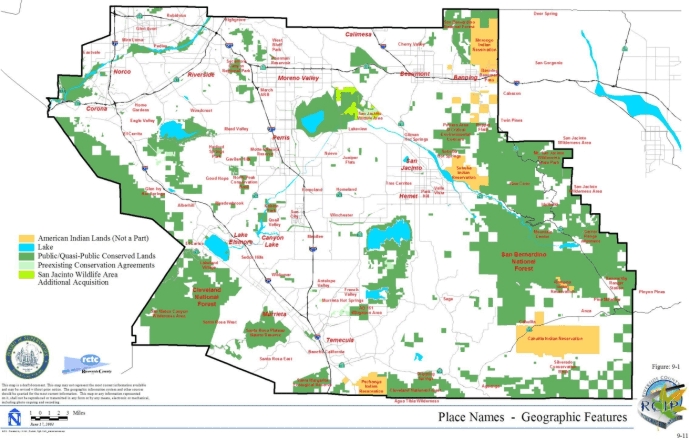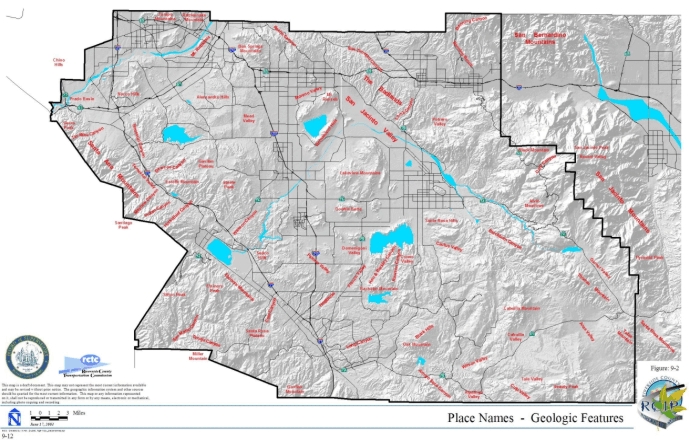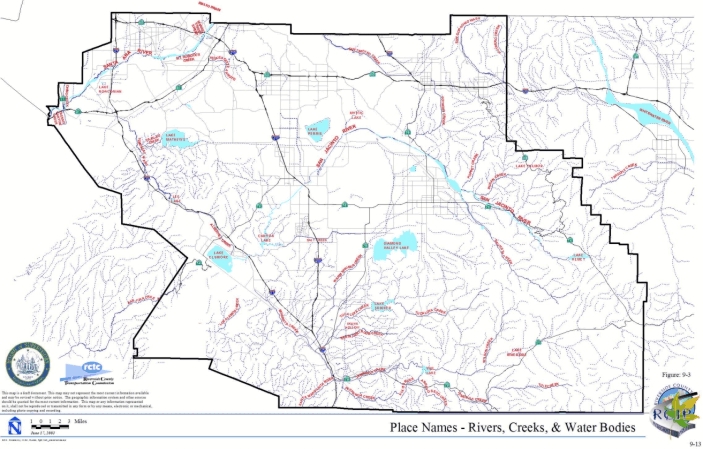SECTION 9.0
CONSERVATION AND INCIDENTAL TAKE ESTIMATES
9.1 OVERALL CONSERVATION AND IMPACT ESTIMATES OF VEGETATION COMMUNITIES
| TABLE 9-1 OVERALL VEGETATION COMMUNITY CONSERVATION AND IMPACT ESTIMATES |
|||||||||||||||||||||||||||||||||
|---|---|---|---|---|---|---|---|---|---|---|---|---|---|---|---|---|---|---|---|---|---|---|---|---|---|---|---|---|---|---|---|---|---|
| Vegetation Community | Total Acres in Plan Area* |
Total Acres Conserved |
Percent of Total Vegetation Community Acres Conserved in Plan Area |
Total Acres Potentially Affected* |
Percent of Total Vegetation Community Acres Potentially Affected in Plan Area |
||||||||||||||||||||||||||||
| Agriculture | 169,480 | 20,020 | 12% | 149,460 | 88% | ||||||||||||||||||||||||||||
| Chaparral | 434,950 | 272,280 | 63% | 162,670 | 37% | ||||||||||||||||||||||||||||
| Cismontane Alkali Marsh | 1,260 | 40 | 3% | 1,220 | 97% | ||||||||||||||||||||||||||||
| Coastal Sage Scrub | 156,450 | 81,720 | 52% | 74,730 | 48% | ||||||||||||||||||||||||||||
| Desert Scrubs | 14,570 | 4,990 | 34% | 9,580 | 66% | ||||||||||||||||||||||||||||
| Grassland | 154,140 | 42,820 | 28% | 111,320 | 72% | ||||||||||||||||||||||||||||
| Meadows and Marshes | 1,020 | 510 | 50% | 510 | 50% | ||||||||||||||||||||||||||||
| Montane Coniferous Forest | 29,910 | 20,500 | 69% | 9,410 | 31% | ||||||||||||||||||||||||||||
| Playas and Vernal Pools | 7,910 | 6,750 | 85% | 1,160 | 15% | ||||||||||||||||||||||||||||
| Riparian Scrub, Woodland, Forest | 15,030 | 11,190 | 74% | 3,840 | 26% | ||||||||||||||||||||||||||||
| Riversidean Alluvial Fan Sage Scrub | 7,940 | 5,230 | 66% | 2,710 | 34% | ||||||||||||||||||||||||||||
| Unknown | 1,350 | 1,240 | 92% | 110 | 8% | ||||||||||||||||||||||||||||
| Water | 12,210 | 10,340 | 85% | 1,870 | 15% | ||||||||||||||||||||||||||||
| Woodlands and Forests | 34,300 | 23,500 | 69% | 10,800 | 31% | ||||||||||||||||||||||||||||
| Developed or Disturbed Land | 218,260 | 4,780 | 2% | 213,480 | 98% | ||||||||||||||||||||||||||||
| TOTALS | 1,258,780 | 505,910 | 752,870 | ||||||||||||||||||||||||||||||
* This includes the following acreages of each Vegetation Community on American Indian Lands that, while within the Plan Area, are not a part of the Plan:
|
|||||||||||||||||||||||||||||||||
9.2 COVERED SPECIES
➤ Conservation Strategy
(1) Global Biological Goal
(2) Global Biological Objectives
Amphibians:
Birds:
Fish:
Invertebrates:
Plants:
Reptiles:
- The Protection of Narrow Endemic Plant Species policies presented in Section 6.1.3 of this document shall be implemented for the benefit of the following species. Other species survey requirements associated with the MSHCP are documented in Section 6.1.3 and 6.3.2. of this document A complete summary of all MSHCP species survey requirements is provided in Appendix E to this document.
- The Additional Survey Needs and Procedures policies presented in Section 6.3.2 of this document shall be implemented for the benefit of the following species. Other species survey requirements associated with the MSHCP are documented in Section 6.1.3 and 6.3.2. of this document A complete summary of all MSHCP species survey requirements is provided in Appendix E to this document.
Amphibians:
Birds:
Mammals:
Plants:
- Covered Activities within the Criteria Area and Allowable Uses within the MSHCP Conservation Area shall be implemented in accordance with the siting, construction, design, operations and maintenance guidelines included in Section 7.0 of this document.
- Monitoring and management activities shall be undertaken for each of the MSHCP Covered Species. Monitoring and management activities are described in Sections 5.2 and 5.3 of this document.
(3) Species-Specific Biological Objectives
(4) Monitoring and Management Activities
➤ Species Accounts Maps



➤ Definitions
➤ Species Conservation and Take Summary
| TABLE 9-3 REQUIREMENTS TO BE MET FOR 28 SPECIES PRIOR TO INCLUDING THOSE SPECIES ON THE LIST OF COVERED SPECIES ADEQUATELY CONSERVED1 |
|
|---|---|
| COMMON NAME/ SCIENTIFIC NAME |
REQUIREMENT |
| REPTILES | |
| San Bernardino mountain kingsnake Lampropeltis zonata parvirubra |
In order for this species to become a Covered Species Adequately Conserved, a Memorandum of Understanding must be executed with the Forest Service that addresses management for this species on Forest Service Land. |
| San Diego mountain kingsnake Lampropeltis zonata pulchra |
In order for this species to become a Covered Species Adequately Conserved, a Memorandum of Understanding must be executed with the Forest Service that addresses management for this species on Forest Service Land. |
| southern rubber boa Charina bottae umbratica |
In order for this species to become a Covered Species Adequately Conserved, a Memorandum of Understanding must be executed with the Forest Service that addresses management for this species on Forest Service Land. |
| southern sagebrush lizard Sceloporus graciosus vandenburgianus |
In order for this species to become a Covered Species Adequately Conserved, a Memorandum of Understanding must be executed with the Forest Service that addresses management for this species on Forest Service Land. |
| BIRDS | |
| California spotted owl Strix occidentalis occidentalis |
In order for this species to become a Covered Species Adequately Conserved, a Memorandum of Understanding must be executed with the Forest Service that addresses management for this species on Forest Service Land. |
| grasshopper sparrow Ammodramus savannarum |
Species Specific Conservation Objective: Within the MSHCP Conservation Area, maintain occupancy within 3 large Core Areas (100 percent) and at least 3 of the 4 smaller Core Areas (75 percent) in at least 1 year out of any 5 consecutive year period. In order for this species to become a Covered Species Adequately Conserved, the following conservation must be demonstrated: Include within the MSHCP Conservation Area at least 8,000 acres in 7 Core Areas. Core areas may include the following: 1) Prado Basin, 2) Lake Skinner/Diamond Valley Lake/Johnson Ranch area, 3) Lake Mathews-Estelle Mountain, 4) Badlands, 5) Box Springs, 6) Santa Rosa Plateau/Tenaja, 7) Kabian Park, 8) Steele Peak, 9) Sycamore Canyon, 10) Potrero, and 11) Mystic Lake/San Jacinto Wildlife Area. Three of the 7 Core Areas will be large, consisting of a minimum of 2,000 acres of grassland habitat or grassland-dominated habitat (<20 percent shrub cover). The other 4 Core Areas may be smaller but will consist of at least 500 acres of contiguous grassland habitat or grassland-dominated habitat (<20 percent shrub cover). Five of the 7 Core Areas will be demonstrated to support at least 20 grasshopper sparrow pairs with evidence of successful reproduction within the first 5 years after permit issuance. Successful reproduction is defined as a nest which fledged at least one known young. |
| Lincoln's sparrow (breeding) Melospiza lincolnii |
Species Specific Conservation Objective: Within the MSHCP Conservation Area, maintain occupancy within 3 large Core Areas (100 percent) in at least 1 year out of any 5 consecutive-year period. In order for this species to become a Covered Species Adequately Conserved, the following conservation must be demonstrated: Include within the MSHCP Conservation Area at least 100 acres in 3 Core Areas. Core Areas may include the following: (1) Tahquitz Valley; (2) Round Valley; (3) Garner Valley. The three Core Areas will be large, consisting of a minimum of 50 acres of montane meadow, wet montane meadow, and edges of montane riparian or riparian scrub. The Core Areas will be demonstrated to support at least 20 Lincoln's sparrow pairs with evidence of successful reproduction within the first 5 years after permit issuance. Successful reproduction is defined as a nest which fledged at least one known young. |
| Williamson's sapsucker Sphyrapicus thyroideus |
In order for this species to become a Covered Species Adequately Conserved, a Memorandum of Understanding must be executed with the Forest Service that addresses management for this species on Forest Service Land. |
| MAMMALS | |
| San Bernardino flying squirrel Glaucomys sabrinus californicus |
Species Specific Conservation Objective: In order for this species to become a Covered Species Adequately Conserved, the following conservation must be demonstrated: Within the MSHCP Conservation Area, confirm occupation of 1000 ha (2470 acres) with a mean density of at least 2 individuals per hectare (2 individuals per 2.47 acres) in the San Jacinto mountains; and in the San Bernardino Mountains confirm occupation of 100 ha. |
| PLANTS | |
| beautiful hulsea Hulsea vestita ssp. callicarpha |
Species Specific Conservation Objective: In order for this species to become a Covered Species Adequately Conserved, the following conservation must be demonstrated: Within the MSHCP Conservation Area, confirm 16 localities (locality in this sense is not smaller than one quarter section) with no fewer than 50 individuals each (unless a smaller population has been demonstrated to be self-sustaining). |
| California bedstraw Galium californicum ssp. primum |
In order for this species to become a Covered Species Adequately Conserved, a Memorandum of Understanding must be executed with the Forest Service that addresses management for this species on Forest Service Land. |
| California muhly Muhlenbergia californica |
Species Specific Conservation Objective: In order for this species to become a Covered Species Adequately Conserved, the following conservation must be demonstrated: Within the MSHCP Conservation Area, confirm 10 localities (locality in this sense is not smaller than one quarter section) containing at least 50 clumps (unless a smaller population has been demonstrated to be self-sustaining). |
| chickweed oxytheca Oxytheca caryophylloides |
Species Specific Conservation Objective: In order for this species to become a Covered Species Adequately Conserved, the following conservation must be demonstrated: Within the MSHCP Conservation Area, confirm 10 localities (locality in this sense is not smaller than one quarter section) managed with 1,000 individuals each (unless a smaller population has been demonstrated to be self-sustaining). |
| Cleveland's bush monkeyflower Mimulus clevelandii |
In order for this species to become a Covered Species Adequately Conserved, a Memorandum of Understanding must be executed with the Forest Service that addresses management for this species on Forest Service Land. |
| cliff cinquefoil Potentilla rimicola |
Species Specific Conservation Objective: In order for this species to become a Covered Species Adequately Conserved, the following conservation must be demonstrated: Within the MSHCP Conservation Area, confirm five localities (locality in this sense is not smaller than one quarter section). |
| Coulter's matilija poppy Romneya coulteri |
Species Specific Conservation Objective: In order for this species to become a Covered Species Adequately Conserved, the following conservation must be demonstrated: Within the MSHCP Conservation Area, confirm 30 localities (locality in this sense is not smaller than one quarter section). |
| Fish's milkwort Polygala cornuta var. fishiae |
Species Specific Conservation Objective: In order for this species to become a Covered Species Adequately Conserved, the following conservation must be demonstrated: Within the MSHCP Conservation Area, confirm 10 localities (locality in this sense is not smaller than one quarter section) with at least 50 individuals (ramets or genets) each (unless a smaller population has been demonstrated to be self-sustaining). |
| graceful tarplant Holocarpha virgata ssp. elongata |
Species Specific Conservation Objective: In order for this species to become a Covered Species Adequately Conserved, the following conservation must be demonstrated: Within the MSHCP Conservation Area, confirm 10 localities (locality in this sense is not smaller than one quarter section) with 1,000 individuals each (unless a smaller population has been demonstrated to be self-sustaining). |
| lemon lily Lilium parryi |
In order for this species to become a Covered Species Adequately Conserved, a Memorandum of Understanding must be executed with the Forest Service that addresses management for this species on Forest Service Land. |
| Mojave tarplant Deinandra mohavensis |
Species Specific Conservation Objective: In order for this species to become a Covered Species Adequately Conserved, the following conservation must be demonstrated: Include within the MSHCP Conservation Area at least four localities (locality in this sense is not smaller than one quarter section) occupying at least 100 acres. |
| ocellated Humboldt lily Lilium humboldtii ssp. ocellatum |
In order for this species to become a Covered Species Adequately Conserved, a Memorandum of Understanding must be executed with the Forest Service that addresses management for this species on Forest Service Land. |
| Parry's spine flower Chorizanthe parryi var. parryi |
Species Specific Conservation Objective: In order for this species to become a Covered Species Adequately Conserved, the following conservation must be demonstrated: Within the MSHCP Conservation Area, confirm 10 localities (locality in this sense is not smaller than one quarter section) with at least 1,000 individuals (unless a smaller population has been demonstrated to be self-sustaining). |
| peninsular spine flower Chorizanthe leptotheca |
Species Specific Conservation Objective: In order for this species to become a Covered Species Adequately Conserved, the following conservation must be demonstrated: Within the MSHCP Conservation Area, confirm 10 localities (locality in this sense is not smaller than one quarter section) with at least 1,000 individuals (unless a smaller population has been demonstrated to be self-sustaining). |
| Plummer's mariposa lily Calochortus plummerae |
Species Specific Conservation Objective: In order for this species to become a Covered Species Adequately Conserved, the following conservation must be demonstrated: Within the MSHCP Conservation Area, confirm six localities (locality in this sense is not smaller than one quarter section) of at least 500 individuals each (unless a smaller population has been demonstrated to be self-sustaining). |
| Rainbow manzanita Arctostaphylos rainbowensis |
Species Specific Conservation Objective: In order for this species to become a Covered Species Adequately Conserved, the following conservation must be demonstrated: Within the MSHCP Conservation Area, confirm 10 localities (locality in this sense is not smaller than one quarter section) with more than 50 individuals each (unless a smaller population has been demonstrated to be self-sustaining). |
| shaggy-haired alumroot Heuchera hirsutissima |
In order for this species to become a Covered Species Adequately Conserved, a Memorandum of Understanding must be executed with the Forest Service that addresses management for this species on Forest Service Land. |
| small-flowered microseris Microseris douglasii var. platycarpha |
Species Specific Conservation Objective: In order for this species to become a Covered Species Adequately Conserved, the following conservation must be demonstrated: Within the MSHCP Conservation Area, confirm 10 localities (locality in this sense is not smaller than one quarter section) with at least 1,000 individuals (unless a smaller population has been demonstrated to be self-sustaining). |
| sticky-leaved dudleya Dudleya viscida |
In order for this species to become a Covered Species Adequately Conserved, a Memorandum of Understanding must be executed with the Forest Service that addresses management for this species on Forest Service Land. |
| Notes: 1 The species-specific conservation objectives listed in this table comprise only a portion of the objectives that must be satisfied for each species. The objectives summarized in Table 9-2 and presented in detail in the species accounts of the MSHCP Reference Document, Volume II must also be fulfilled for each species. |
|
9.3 MINIMIZATION AND MITIGATION MEASURES
TABLE 9-2
SPECIES CONSERVATION SUMMARY

